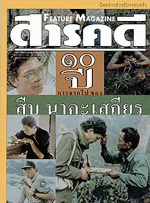Click here to visit the Website
| ส า ร บั ญ | |
| โลกใบใหญ่ | |
| โลกใบเล็ก | |
 ที่ปรึกษาหัวขโมย |
|
 จินตนาการในวัยชรา |
|
| อ่านเอาเรื่อง | |
| "โพล" (การเมือง) : เครื่องมืออันตราย ? | |
| สิ่งแวดล้อม | |
| สัมพันธภาพของคนกับป่า | |
| เพื่อความเข้าใจในแผ่นดิน | |
| เรื่องของกระจาน | |
| สัตว์-พรรณพืช | |
ซู
ฟอสซิลทีเร็กซ์
ที่สมบูรณ์แบบ
ที่สุดในโลก |
|
| วรรณกรรม | |
| "ขุมทรัพย์ที่ปลายฝัน" กับ ประชา หุตานุวัตร และ ปราบดา หยุ่น | |
| พิพิธภัณฑ์ | |
| พิพิธภัณฑ์แห่งชีวิต ครูมนตรี ตราโมท | |
| ประชาสัมพันธ์ | |
| สืบสานงานสืบ บอกเล่าคุณค่า ผืนป่าตะวันตก | |
| ที่นี่มีอะไร | |
| โลกบันเทิง | |
| ภาพยนตร์ | |
 จอห์นวูกับเส้นทาง สู่ฮอลลีวูด (๒) ความยืดหยุ่น ยุคหลังฟอร์ด |
|
| ดนตรี | |
| หลักไมล์ ในเส้นทางดนตรีร็อก (๑๐) | |
| โลกธรรมชาติ และวิทยาการ | |
| โลกวิทยาการ | |
| น้ำ : ปัญหาและทางออก | |
| ส่องจักรวาล | |
| เส้นทางสู่ความรู้
เรื่องเอกภพ (๑๓) การค้นพบ การขยายตัว ของเอกภพ (ตอนที่ ๓) |
|
| คอลัมน์ประจำ - ปกิณกะ | |
| โลกรายเดือน | |
| เชิญดอกไม้ | |
กุหลาบ |
|
| จากบรรณาธิการ | |
| บ้านพิพิธภัณฑ์ | |
| สุนทร
ชุโนทัยสวัสดิ์ แห่งพิพิธภัณฑ์สุนทร  www.sunthorn.com |
|
| เขียนถึงสารคดี | |
| Feature@ Sarakadee.com | |
| สัมภาษณ์ | |
| ดร. ไทสัน
อาร์. โรเบิร์ต ฝรั่งบ้าปลาแห่งลุ่มน้ำโขง  |
|
| สารคดีต่างประเทศ | |
สวัสดี...โฮจิมินห์ |
|
| ศิลปะ | |
| จิตรกรผู้เดินตามธรรมชาติ จอห์น คอนสเตเบิล  |
|
| บันทึกนักเดินทาง | |
ลูกเก้งหม้อ
ผู้หลงทาง |
|
| คิดสร้างต่างสรรค์ | |
 มารีและปิแอร์ กูรี นักวิทยาศาสตร์ใจบุญ |
|
| ข้างครัว | |
 ครัวสมัยหิน |
|
| เสียงจากอุษาคเนย์ | |
| รู้จักพุทธสายวิปัสสนา ของไทยและพม่า | |
| สยามร่วมสมัย | |
| หวย กข. | |
| ซองคำถาม | |
| สัญลักษณ์เพศชาย-หญิง | |
| เหตุใดจึงใช้ชื่อ "คณะราษฎร" | |
| โอเค ซิกาแรต | |
| ทำไมทองคำจึงมีค่า | |
| เสียงหึ่ง ๆ ของฝึ้ง | |
| แม่นางกาหลง | |
| เฮโลสาระพา | |
| Special Attractions | |
 |
Cover: Always
at work, Sueb Nakhasathien's pleasure was in learning, writing, and
looking for more ways to protect Thailand's wildlife from destruction.
He would be 51 if he were alive today. |
 |
Sueb
Nakasathien: Ten Years After Story Vanchai Tan About
10 a.m. on September 1, 1990, a wildlife sanctuary ranger entered
Sueb's apartment and found Sueb Nakasathien lying on his bed. A piece
of paper next to him said, "I intended to kill myself. No one is
involved in this." |
 |
The
Hidden After-effects of War Story and photos : Weerasak Chansongsang It was a
beautiful sunny morning, when 40 year-old Wacharaporn Kornkamol
readied himself for his daily chores. The cornfields stretching out
ahead of him belonged to his family for years, some of those years in
which he had tired of the efforts and rented parts out. Nonetheless,
this was his livelihood. Wacharaporn put on his field boots, and made
his way through the neatly manicured cornfields - the tractor's
periodic plowing had done wonders for the soil. He suddenly noticed
what appeared to be the first cropping of corn, and rushed to examine
his earnings. Suddenly, an explosion. Wacharaporn without his left
leg, but worse yet, without a justified explanation. |
 |
Wild
Elephants and the Croppers of Kuiburi Story by Jakkapan Kangwan Photos by Bansit Bunyaratavej
Kuiburi National Park, established
in 1990, near the Thailand-Myanmar border, was once dense jungle and
the refuge of communists. Before the communists,
there were elephants. When in 1969 the Thai government encouraged
settlement in these "pink areas" to drive away communists,
the effort also drove away elephants from their original trails. |
 |
พูดจาภาษาหมอ "เพื่อนหมูฯ" |





